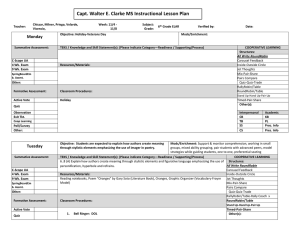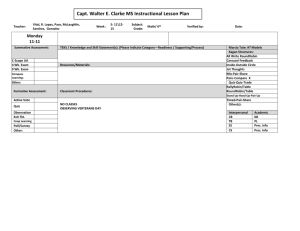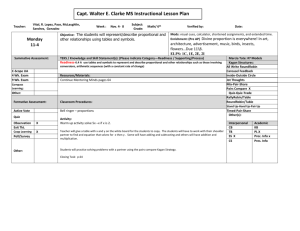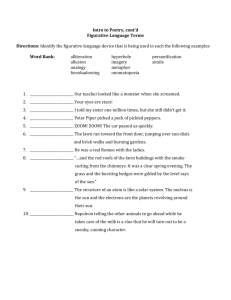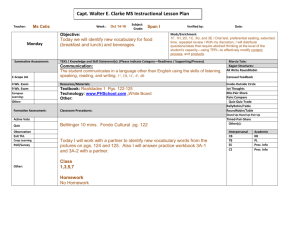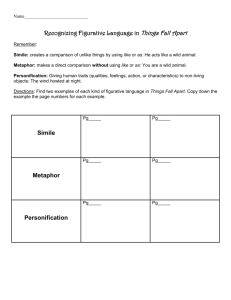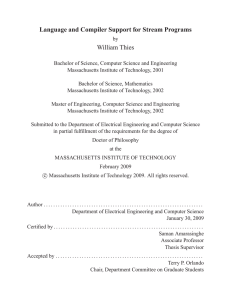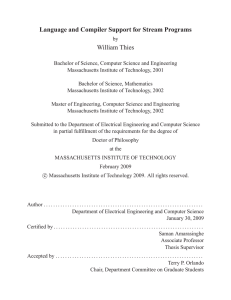Moss Point High School
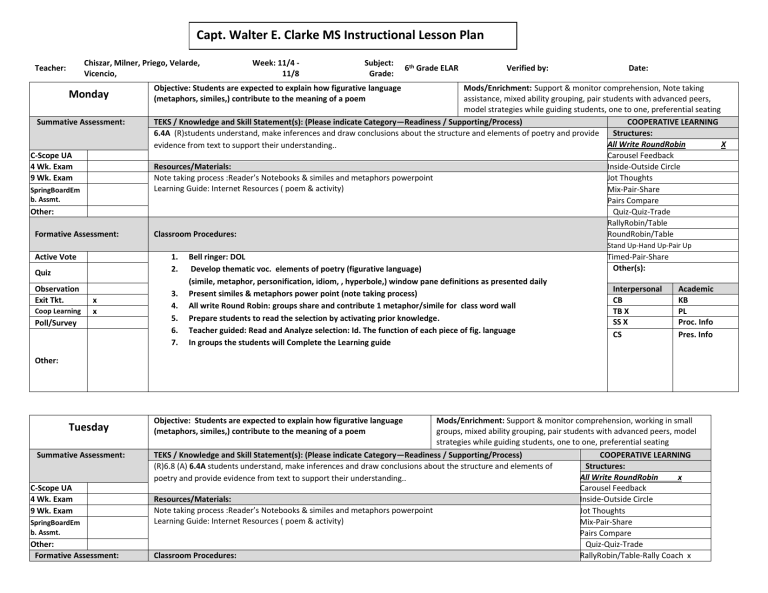
Capt. Walter E. Clarke MS Instructional Lesson Plan
Teacher:
Chiszar, Milner, Priego, Velarde,
Vicencio,
Monday
C-Scope UA
4 Wk. Exam
9 Wk. Exam
SpringBoardEm b. Assmt.
Other:
Summative Assessment:
Formative Assessment:
Active Vote
Quiz
Observation
Exit Tkt.
Coop Learning x x
Poll/Survey
Week: 11/4 -
11/8
Subject:
Grade:
6 th Grade ELAR Verified by: Date:
Objective: Students are expected to explain how figurative language
(metaphors, similes,) contribute to the meaning of a poem
Resources/Materials:
Note taking process :Reader’s Notebooks & similes and metaphors powerpoint
Learning Guide: Internet Resources ( poem & activity)
Classroom Procedures:
Mods/Enrichment: Support & monitor comprehension, Note taking assistance, mixed ability grouping, pair students with advanced peers, model strategies while guiding students, one to one, preferential seating
TEKS / Knowledge and Skill Statement(s): (Please indicate Category—Readiness / Supporting/Process)
6.4A (R)students understand, make inferences and draw conclusions about the structure and elements of poetry and provide evidence from text to support their understanding..
COOPERATIVE LEARNING
Structures:
All Write RoundRobin X
Carousel Feedback
Inside-Outside Circle
Jot Thoughts
Mix-Pair-Share
Pairs Compare
Quiz-Quiz-Trade
RallyRobin/Table
RoundRobin/Table
Stand Up-Hand Up-Pair Up
Timed-Pair-Share
Other(s):
1.
Bell ringer: DOL
2.
Develop thematic voc. elements of poetry (figurative language)
(simile, metaphor, personification, idiom, , hyperbole,) window pane definitions as presented daily
3.
Present similes & metaphors power point (note taking process)
4.
All write Round Robin: groups share and contribute 1 metaphor/simile for class word wall
5.
Prepare students to read the selection by activating prior knowledge.
6.
Teacher guided: Read and Analyze selection: Id. The function of each piece of fig. language
7.
In groups the students will Complete the Learning guide
Interpersonal Academic
CB
TB X
SS X
KB
PL
Proc. Info
CS Pres. Info
Other:
Tuesday
Summative Assessment:
C-Scope UA
4 Wk. Exam
9 Wk. Exam
SpringBoardEm b. Assmt.
Other:
Formative Assessment:
(metaphors, similes,) contribute to the meaning of a poem
TEKS / Knowledge and Skill Statement(s): (Please indicate Category—Readiness / Supporting/Process)
(R)6.8 (A) 6.4A students understand, make inferences and draw conclusions about the structure and elements of poetry and provide evidence from text to support their understanding..
Resources/Materials:
Note taking process :Reader’s Notebooks & similes and metaphors powerpoint
Learning Guide: Internet Resources ( poem & activity)
Classroom Procedures: groups, mixed ability grouping, pair students with advanced peers, model strategies while guiding students, one to one, preferential seating
COOPERATIVE LEARNING
Structures:
All Write RoundRobin x
Carousel Feedback
Inside-Outside Circle
Jot Thoughts
Mix-Pair-Share
Pairs Compare
Quiz-Quiz-Trade
RallyRobin/Table-Rally Coach x
Active Vote
Quiz
Observation x
Exit Tkt.
Coop Learning x
Poll/Survey
Other:
Continued Lesson………………
BELL Ringer: DOL
1.
Develop thematic voc. elements of poetry (figurative language) a.
(personification) window pane definitions as presented daily
2.
Introduce the poem “ The sky is low” by Emily Dickenson.
3.
conduct choral reading assigning groups to read a line from the poem
4.
ask students to try to define unfamiliar voc.
5.
Ask students to identify ex. of personification
6.
Discuss why the author has chosen to personify the weather
7.
Repeat procedure with “ Two sun Flowers Move in The Yellow Room”
8.
Allow students to complete a personification chart for April Rain Song
RoundRobin/Table
Stand Up-Hand Up-Pair Up
Timed-Pair-Share
Other(s):
Interpersonal Academic
CB KBx
TBX
SSX
PL
Proc. Info
CS Pres. Info
Wednesday
Summative Assessment:
C-Scope UA
4 Wk. Exam
9 Wk. Exam
SpringBoardEm b. Assmt.
Other:
Formative Assessment:
Active Vote
Quiz
Observation x
Exit Tkt. x
Coop Learning
Poll/Survey x
Other:
( personification) contribute to the meaning of a poem groups, mixed ability grouping, pair students with advanced peers, model strategies while guiding students, one to one, preferential seating
TEKS / Knowledge and Skill Statement(s): (Please indicate Category—Readiness / Supporting/Process)
(R)6.4A students understand, make inferences and draw conclusions about the structure and elements of poetry and provide evidence from text to support their understanding. 6.2B use context to determine or clarify the meaning of unfamiliar words
Resources/Materials:
Literary analysis:
Prentice Hall pg. 589 “April Rain Song”
Pg.929 Personification chart
Classroom Procedures:
BELL Ringer: DOL
9.
Develop thematic voc. elements of poetry (figurative language) a.
(personification) window pane definitions as presented daily
10.
Introduce the poem “ The sky is low” by Emily Dickenson.
11.
conduct choral reading assigning groups to read a line from the poem
12.
ask students to try to define unfamiliar voc.
13.
Ask students to identify ex. of personification
14.
Discuss why the author has chosen to personify the weather
15.
Repeat procedure with “ Two sun Flowers Move in The Yellow Room”
16.
Allow students to complete a personification chart for April Rain Song
COOPERATIVE LEARNING
Structures:
All Write RoundRobin
Carousel Feedback
Inside-Outside Circle
Jot Thoughts
Mix-Pair-Share
Pairs Compare
Quiz-Quiz-Trade
RallyRobin/Tablex
RoundRobin/Table
Stand Up-Hand Up-Pair Up
Timed-Pair-Share
Other(s):
Interpersonal Academic
CB
TB x
SS
CS
KB x
PL
Proc. Info
Pres. Info
Thursday
Summative Assessment:
C-Scope UA
4 Wk. Exam
9 Wk. Exam
SpringBoardEm b. Assmt.
Other:
Formative Assessment:
Active Vote
Quiz
Observation x
Exit Tkt. x
Coop Learning
Poll/Survey x
Other:
Friday
Summative Assessment:
C-Scope UA
4 Wk. Exam
9 Wk. Exam
SpringBoardEm b. Assmt.
Other:
Formative Assessment:
Active Vote
Quiz
(idioms) contribute to the meaning of a poem note taking assistance
TEKS / Knowledge and Skill Statement(s): (Please indicate Category—Readiness / Supporting/Process)
(R)6.4A students understand, make inferences and draw conclusions about the structure and elements of poetry and provide evidence from text to support their understanding..
Resources/Materials:
Prentice Hall pg. 1000
Idioms Power Point website resources
Classroom Procedures:
COOPERATIVE LEARNING
Structures:
All Write RoundRobin
Carousel Feedback
Inside-Outside Circle
Jot Thoughts
Mix-Pair-Share
Pairs Compare
Quiz-Quiz-Trade
RallyRobin/Table
RoundRobin/Table
Stand Up-Hand Up-Pair Up
BELL Ringer: DOL
1.
Develop thematic voc. elements of poetry (figurative language) (idioms) window pane definitions as presented daily
2.
Review examples on idiom Chart
3.
Complete activity sequence
Closing Activity: Think of 3 idioms you know and explain their meaning (Timed pair-share)
Other(s):
Interpersonal Academic
CB KB x
TB x
SS
PL
Proc. Info
CS Pres. Info
(hyperbole) contribute to the meaning of a poem. To define hyperbole, examine how it is used in literature and how it enhances literature.
Resources/Materials:
“Where the sidewalk Ends” by Shel Silverstein
Classroom Procedures: groups, mixed ability grouping, pair students with advanced peers, model strategies while guiding students, one to one, preferential seating
TEKS / Knowledge and Skill Statement(s): (Please indicate Category—Readiness / Supporting/Process)
(R)6.4A students understand, make inferences and draw conclusions about the structure and elements of poetry and provide evidence from text to support their understanding..
COOPERATIVE LEARNING
Structures:
All Write RoundRobin
Carousel Feedback
Inside-Outside Circle
Jot Thoughts
Mix-Pair-Share
Pairs Compare X
Quiz-Quiz-Trade
RallyRobin/Table
RoundRobin/Table x
Stand Up-Hand Up-Pair Up
1.
Bell ringer: DOL
2.
Develop thematic voc. elements of poetry (figurative language)
Timed-Pair-Share
Other(s):
Observation X
Exit Tkt. x
Coop Learning x
Poll/Survey
Other:
Special Instructions:
Comments/Concerns:
(hyperbole,) window pane definitions as presented daily
3.
Provide students with examples of hyperboles.
4.
Allow students to add to the list of hyperboles as read in previous pieces of literature
5.
Examine the poem identifying hyperbole
Interpersonal Academic
CB KB
TB x PL
SS x
CS
Proc. Info
Pres. Info
